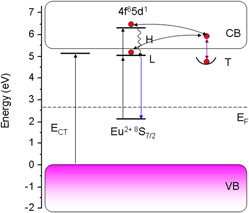Crossref Citations
This article has been cited by the following publications. This list is generated based on data provided by
Crossref.
Smet, Philippe F.
Van den Eeckhout, Koen
De Clercq, Olivier Q.
and
Poelman, Dirk
2015.
Including Actinides.
Vol. 48,
Issue. ,
p.
1.
Ju, Guifang
Hu, Yihua
Chen, Li
Jin, Yahong
Yang, Zhongfu
and
Wang, Tao
2015.
Photoluminescence properties of Ce^3+and Tb^3+-activated Ba_2Mg(PO_4)_2.
Optical Materials Express,
Vol. 5,
Issue. 1,
p.
1.
Santos, Ricardo D.S.
and
dos S. Rezende, Marcos V.
2016.
Eu doping and reduction into barium orthophosphates.
Optical Materials,
Vol. 58,
Issue. ,
p.
136.
Bos, Adrie
2017.
Thermoluminescence as a Research Tool to Investigate Luminescence Mechanisms.
Materials,
Vol. 10,
Issue. 12,
p.
1357.
Hora, Daniela A.
Silva, Ariosvaldo J.S.
Nascimento, Patresio A.M.
Sampaio, David V.
Moulton, Benjamin J.A.
Silva, Ronaldo S.
and
Rezende, Marcos V. dos S.
2019.
Effect of the amounts of Li+ additive on the luminescence properties of LiBaPO4:Eu phosphor.
Optical Materials,
Vol. 89,
Issue. ,
p.
329.
Huang, Yanlin
Qin, Jie
Fan, Zutao
Wei, Donglei
and
Seo, Hyo Jin
2019.
Photoenergy Conversion Behaviors of Photoluminescence and Photocatalysis in Silver-Coated LiBaPO4:Eu2+.
Inorganic Chemistry,
Vol. 58,
Issue. 19,
p.
13161.
Sousa, Marcos F.
Oliveira, Joéslei L.
Santos, Ricardo D.S.
Otsuka, André M.
Couto dos Santos, Marcos A.
Lima, Heveson
and
Rezende, Marcos V.dos S.
2021.
Defect and spectroscopy properties of Eu-doped LiMgPO4 phosphors.
Optical Materials,
Vol. 122,
Issue. ,
p.
111756.
Sousa, Marcos F.
de Mesquita, Bruno Ribeiro
Oliveira, Joéslei L.
Santos, Ricardo D.S.
and
Rezende, Marcos V. dos S.
2023.
Defect and spectroscopy properties of Eu-doped RbBaPO4 phosphors: A computer simulation study.
Journal of Physics and Chemistry of Solids,
Vol. 181,
Issue. ,
p.
111480.
Hora, Daniela A.
Silva, Ariosvaldo J.S.
Oliveira, William A.
Monteiro, Stéfanny S.
Oliveira, Matheus S.C.
Silva, Eliane P.
Lima, Heveson
Silva, Ronaldo S.
Ferreira, Nilson S.
and
Rezende, Marcos V. dos S.
2024.
The effect of laser beam shaping on the structural and XEOL properties of laser-sintered LiBaPO4:Eu ceramics.
Ceramics International,
Vol. 50,
Issue. 24,
p.
55669.



